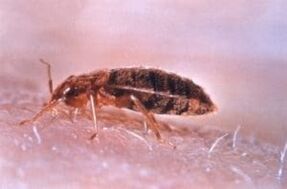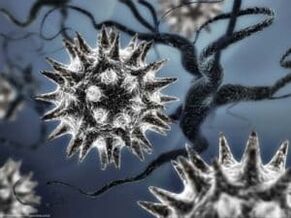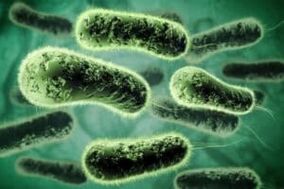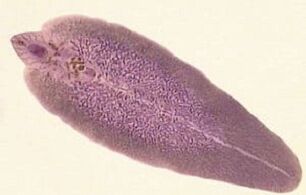By knowing the routes of entry of parasites into the body, it is possible to take precautionary measures in contact with possible sources of infection. What are helminths, as intestinal parasites, are known to many. However, the common man is no less familiar with the species that live in the circulatory system, the subcutaneous lymph, the muscles, the brain and the internal organs.
All types of parasites in the human body are classified into representatives: protozoa, flat and round worms, arthropods and their larvae.Viruses, pathogenic bacteria and fungi can be classified as parasites, but are distinguished into a separate group. Infectious diseases are divided into: viral, fungal, bacterial and parasitic. The classification of human parasites includes - a unique species of fish (common vandal), capable of penetrating the human urethra (random host).
Parasitism and its types

What are parasites? These are organisms that live at the expense of another person, that are not genetically related to him and enter into competitive relationships, that is, interfere in life. The concept of parasitism should not be extended to microorganisms that live in the body without causing particular harm. In nature, there are plant and animal parasites, depending on the type of host. During the operation of this lifestyle, the system of parasites and hosts is constantly working. The task of the first: to live from the second, without killing him for a long time.
Classification of pests by type:
- Detection sites: external and internal parasites (exo- and endoparasites).
- Lifestyle: constantly parasitic (mandatory) and free living forms, which under certain conditions begin to exist at the expense of another organism (prosthetic parasites).
- Until the time of contact with the host: temporary and permanent parasites (stationary and periodic).
In the food chain, animal parasites are usually second- or third-class consumers, feeding on herbivores or carnivores. The way the parasite is fed deprives it of many nutrients and / or leads to the destruction of cells and tissues. Host competition often occurs because dangerous residents release toxic metabolic products. This leads to certain symptoms (allergies, digestive disorders, signs of damage to various internal organs).
Viruses

Viruses are intracellular parasites of a protein-genetic structure. Due to the cell materials, they reproduce. The virus is a mandatory parasite.
According to the classification, depending on the type of genetic material, RNA and DNA containing viruses are isolated. The intracellular factors of the first group include:
- Enteroviruses. They multiply in the digestive tract, causing problems in various human organs. Rhinoviruses. Etiological factors of ARVI. Influenza, rabies and tick-borne encephalitis viruses. Papillomaviruses.
The second group includes: adenoviruses (causing acute respiratory infections), herpes and smallpox pathogens.
The viruses, which enter the target cell, undergo their own processes, integrate into the genetic material or are located in the cytoplasm and then reproduce (multiply). Then, cell death occurs as a result of lysis, apoptosis. or deformation of the membrane structure. Some agents (papillomaviruses, Epstein-Barr virus) are capable of causing cell degeneration into malignancies.How viruses penetrate inside:
- Airborne.
- Through the gastrointestinal tract when you drink water and eat food.
- Through the skin and external mucosa, such as the conjunctiva of the eye.
- Through arthropod vectors (insects, ticks).
- As a result of using non-sterile medical devices (syringes, pipettes).
Each virus adapts to a specific cell, distinguishes the target with the help of receptors.
Bacteria

Among bacteria, rickettsiae, intracellular parasites, occupy a special place. These are the most primitive representatives that look like viruses. In humans, these microorganisms cause: typhoid, tick-borne rickets, Rocky Mountain fever. Humans are infected with rickettsiae through the bites of ticks, fleas, lice.
Other intracellular chlamydia parasites cause one of the most common venereal disease (chlamydia) and cause severe eye inflammation, infant pneumonia and enteritis.
Dangerous bacteria include:
- Salmonella is the causative agent of typhoid fever.
- Tetanus stick.
- A pale spurge that causes syphilis due to the difficult diagnosis of the disease, which leads to a delay in treatment.
- Pneumococci, which can cause pneumonia and, less commonly, bacterial meningitis.
- Tuberculosis bacillus, which may not manifest for a long time and then turn into an open form.
- Escherichia coli due to its ability to become resistant to antibiotics. It causes gastroenteritis, rare meningitis and urinary tract infection.
Mushrooms

Disease-causing fungi - human parasites are better protected from the effects of drugs than bacteria. The most common fungal disease is candidiasis (chewing gum), localized in various mucous membranes with a weakened immune system. Mushrooms of the genus Candida live in the body of any healthy person and cause tangible damage only if the protective function fails. In terms of pathogenic bacteria and fungi is a borderline group of microorganisms between non-pathogenic and pathogenic categories. Therefore, as a rule, they are not classified as parasites.
Pathogenic microcellular fungi are human parasites that often cause external bone diseases:
- Keratomycosis. Fungal reproduction occurs in the keratinized area of the skin or in the hair follicles (trichosporia nodosum, versicolor versicolor).
- Dermatophytosis. Pathogens affect not only the skin but also the skin, nails and hair (ringworm, scab).
- Deep fungi. Damage to the skin and nearby tissues, as well as to internal organs. These include histoplasmosis - a serious systemic fungal disease and aspergillosis - damage to the mucous membranes and skin caused by aspergillus.
The classic sources of bacterial and fungal infections are sick, animals, soil, dirty water and food.
Protozoa
Protozoa are another single-celled parasite along with bacteria and fungi. Which protozoan parasites of an individual are isolated according to the systemic position?
- Some types of amoebae are additive parasites. The most famous is the amoeba of dysentery, which enters the human body in the form of a cyst (calm). The pathogen enters the large intestine (lumen form), then penetrates the mucous membrane and affects various internal organs with blood flow. Amoebae are aquatic organisms, so the main source of infection with them is dirty water. Acanthamoeba keratitis is a rare eye disease called acanthamoeba keratitis, which has become more common due to the increasing popularity of contact lenses. Flagellates (Leishmania, Giardia, Trichomonas). Trichomonas is the most common disease of the urinary system, dangerous for its complications (infertility, prostatitis, premature birth, etc. ).
- Apicomplexes (Sporozoans). With the exception of colpodelids, the group includes only obligate parasites (Toxoplasma, Plasmodium malaria, Cryptosporidium, Coccidia, sarkocysts). Sporozoic cysts enter the body after being bitten by insects, eating infected animals or drinking water.
- Ciliates. For humans, balantidia is dangerous, causing diarrhea and ulcers in the intestinal wall as a result of activity in the large intestine. Ciliates are the largest pathogenic unicellular organisms.
The simplest human parasites cause protozoan infections (protozoa). What parasites live in the human nervous system among protozoa? For example, the causative agents of toxoplasmosis and cerebral malaria. Among amoebas, the prosthetic parasite Neglerius Fowler is capable of infecting the nervous system.
Multicellular
Multicellular parasites include flatworms, worms, arachnids and insects. The former, as a rule, settle inside a person (in various systems and internal organs), and some species migrate or penetrate (rishta, larvae of Gnathostoma spinigerum and hookworms, schistosomes) into the subcutaneous layer. Worms are the collective speech of all the worms that cause helminth infestations (helminths).
Common diseases caused by worms
Group of triamteons (digenetic flocks):
- Opisthorchiasis. Causes: types of liver disease, for example, feline and Siberian pulses. The contamination occurs as a result of consuming infected river fish, with poor heat treatment.
- Fascioliasis. It is caused by liver and giant blisters. Infection occurs through the consumption of contaminated water or coastal grass.
- Schistosomiasis. The causative agents of schistosomes (especially bleeding blood) live mainly in warm climates. They penetrate the skin in contact with water.
- Infertility. The cause of the disease is a pulmonary disorder, which is found in hot climates. A worm-infected crab or heat-treated crab is dangerous.

The life cycle of the parasite from the tricot group is complex, including several stages of larvae and gastropods as intermediate vectors. Fluks are vertebrate animal parasites that act as temporary and permanent hosts. The individual stages of the larvae are able to grow without fertilization. Flukes for mounting and feeding inside the host are absorbent.
Movies are mandatory parasites of the human small intestine. Their body consists of parts (proglottids), which are periodically limited and come out together with the fertilized eggs. The stages of the film life cycle necessarily include the finna (blister worm), which is formed in a temporary owner. The permanent host swallows the Finn, which develops into a conical form (adult). The structural features of the strips are the absence of a digestive system and the absorption of nutrients from the entire surface.
Most common:
- The bovine tapeworm (unarmed tapeworm) causes teniarrhinosis. Infection occurs through the meat of cattle, the muscles of which are contained by the Finns, formed in the body after the animals swallow eggs with food.
- Pork film (reinforced tape) is the causative agent of cysticercosis (Finn stage) and tenia (adult). In addition to the absorbents, the helminth is equipped with a hook edge. A person can simultaneously perform the function of an intermediate and permanent owner.
- The wide band causes bifurcation. Intermediates are copepods and fish. A person can be infected with caviar with salt and freshwater fish that have been cooked or fried.
The parasites feed on blood and tissues (flukes) or digested foods (strips).
Roundworms
What are the common types of parasites in humans (worms)?

- Ascaris. Ascariasis includes migratory (larvae) and intestinal (adult) stages. The larva penetrates the wall of the small intestine, moves to the lungs, bypassing the liver and heart, passing successively through the stages of fusion. It enters the oral cavity, is swallowed again and becomes an adult in the small intestine.
- Pinworm. The causative agent of enterobiasis is fed in the final and initial zones of the small and large intestine, it multiplies in the ileum. Females lay eggs in the anal folds, causing severe itching. Vlasoglav is the cause of hair loss. These parasites in the human body invade the mucous membrane of the original part of the large intestine and feed on fluid tissue and blood.
- Trichinella causes a dangerous disease of trichinosis. In severe cases, the nervous system is damaged. These are real killers, whose larvae penetrate the wall of the small intestine and are transported throughout the body. They mainly enter the striated muscles, can penetrate the eyes, causing pain and swelling of the face, lungs, leading to coughing. So far, no treatment has been devised for complete recovery.
- Toxokara. Distinction between larva (most common) and imaginary (intestinal) toxemia. The invasion is characterized by the severity of allergic reactions. The larvae spread throughout the body, entering the tissues, encapsulating and forming granulomas. Hooks are most common in the tropics and subtropics. With hook infection, worms in the gut secrete proteolytic enzymes that damage the walls and reduce blood clotting. Parasites in an individual occur as a result of the introduction of larvae through the skin by contaminated water. Escherichia coli and related species are tropical parasites. The disease they cause, myeloma, can be asymptomatic for decades. With reduced immunity, worm carriers are at high risk of death (60-85%). Rishta is a subtropical helminth that causes draculasis. The larvae penetrate the intestinal wall. Females reach the subcutaneous layer and when the host is in the water, they expel the larvae through the skin. The temporary host is copepod crayfish.
The peculiarities of the parasite habitat affect the ways they enter the body: contact with contaminated water or land, with the larval stage carriers inhabiting them. Many representatives of roundworms do not have intermediates and belong to geohelminths. Infection with them occurs mainly through contaminated water, unwashed hands, fruits or vegetables, as well as through the consumption of meat from wild animals.
Treatment and terrible consequences of helminthiasis
An important way to diagnose helminthiasis is a blood test. Eosinophils (a type of white blood cell) found in high concentrations along with other signs of infection indicate the presence of a worm and a number of pathogenic protozoa in the body. How are helminths treated? Drugs are used to relieve symptoms and specific treatment. Antiallergic (desensitization) and detoxification treatment is used. Basically, drugs are given by infusion (using a dropper), sometimes injections are used:
- A drug that replaces plasma and removes the effects of toxins.
- Isotonic glucose solution and saline.
- Vitamins C and B6. Sodium bicarbonate (soda), calcium chloride or gluconate.
- Preparations used at high temperatures.
- Hormonal drugs are used in difficult situations (with hepatitis or allergic myocarditis). Potassium intake is combined with them.
- Medications for heart failure and edema.
There is evidence that some parasitic worms, such as the pygmy tapeworm, can cause cancer. The stem cells of the larvae can degenerate into cancerous. Parasites can indirectly cause cancer by weakening the immune system. Interesting data were obtained in the study of the effect of trimatons affecting the liver. As a result of exposure to garbage, normal cells can turn into cancer cells. The parasites are mainly found in the digestive system, but their larvae can penetrate various internal organs. For example, in the kidneys (echinococcosis, schistosomiasis), heart muscle (cysticercosis, hookworm disease), liver (echinococcosis). Parasitic worms in humans often affect the nervous system. Known cysticercosis, echinococcosis, alveoli and schistosomiasis of the brain.
Arthropods
The range of insects includes such well-known ectoparasites as fleas, bugs, diterans that absorb blood. Unlike lice, they are temporary parasites, meaning they live inconsistently with the help of the host. Arthropod parasites in the order of arachnids include the well-known scabies mites. Mating of males and females occurs on the surface of the epithelium. The parasites in the human body then lay their eggs in the keratin layer of the skin, causing severe itching. Many people know what ixodid ticks are. These are arthropod parasites from the arachnid series, including the most famous representative of the taiga - carrier of dangerous infections (tick-borne encephalitis, Lyme disease). Among the diphtheriae that suck blood are: non-malaria and malaria mosquitoes, mosquitoes, pimples, bites, horses and real flies. Some flies, especially kittens, deposit larvae under human skin, causing myiasis. The larvae are able to penetrate the body.








































